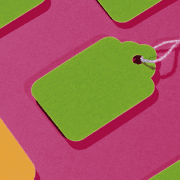Social Media Marketing on Mobile: Grow You Business with These 7 Mobile Content Strategies
The fact that screen sizes have gotten smaller plays a key role in today’s visual content revolution.
Since less information is in your field of vision on a phone (and since only a handful would stay long enough to read lengthy writeups), content needs to be presented in bite-sized but accessible ways. And you know what they say: a picture paints a thousand words.
We are already past the tipping point — the number of mobile users has surpassed the number of desktop users, with more than 60% of the traffic coming from mobile. Among social media users, 80% access their accounts via a mobile device.

Here’s another startling fact: 50% of small businesses need help with marketing on social media. They don’t realize the difference a user experiences while accessing social media from a desktop computer and doing the same from a mobile device.
Posting directly from a mobile device — which apps like Canva’s recently launched iPhone app enable you to do — makes it easier to simulate how the material would look like upon social media publication.
To help guide you on your mobile strategizing, we have scoured through the deepest ends of the internet to put together key tactics which will help you create engaging content for your brand on mobile. Ready?
01. Match the content with your medium
Each social media platform is different from the other, and their layouts change as you access them from mobile devices. Not to mention, there is such a thing asmarketing fatigue. If you cross-promote the same thing across all your social media channels at the same time, your followers
That is why it is important to approach each one of them differently and to focus only on the platforms that have the highest return for your brand.
On Facebook mobile all the content is presented in a single column.
This means you only get a fleeting chance to impress people. If your content is just like everyone else’s, your potential customers will scroll through; but if your content is outstanding enough, you will get a higher engagement rate.

Your visual content should be engaging enough to merit the user’s attention.
Not all visual content are created equally, though. Facebook’s newsfeed format treats image posts and website link posts differently. Even though Facebook pulls open graph images for website links, uploaded image posts get a slightly larger space on the newsfeed as compared to link posts.
So if you want the images to take the center stage, and also want readers to click on links, you could do exactly what JustB – add a link in the description over images.

83% of Twitter users access the micro-blogging website through their smartphones.
In the last few years, images have become an integral part with the social media platform by introducing in-app gifs and rich cards for website links. Every website link on Twitter is now displayed much like Facebook’s, with the hero image as the main image on link post.
Not surprisingly, Twitter started pushing this feature on their mobile app first and then it made its way to the main desktop website.
Also, Twitter photos are not supposed to be square; they need to be rectangular in order to fit in the feed, read forward for the exact dimensions you should be using.

Instagram used to be all about filters and square images, but the image sharing social media app recently announced a big change — portrait and landscape images are now allowed on the app.
While many fashion brands like Zara are taking advantage of this new change, most of the other brands are sticking to the square image format.
Why?
Because square images take the most space on Instagram News feed, while other differently-oriented images will always have a bit of white space on the sides.
While brands should pay attention to every image that they post, they should also make sure the account’s feed overall looks good as well. Posted images shouldn’t look out of place — they should blend in together.

02. Invest in your cover photo
Whether it’s Facebook or Twitter, the header image is the first image people see, and it’s the best opportunity to give followers a great impression.
Your brand’s header should give your followers the message you are trying to convey. For instance, Red Bull —which always claims that their drinks give people ‘wings’ — makes sure that their Facebook feed is filled with adventurous photos and videos. Hence this adrenaline-filled cover photo makes complete sense for them.

Disney Pixar, on the other hand, uses cover photos to let their fans stay updated about all the new releases — which in this case is the highly anticipated Finding Dory.

03. Maximize your phone’s native camera by taking creative selfies
Taking out a professional camera to send out every little update, is not just time consuming, it takes out that “genuineness” you want to impart to your fans. (And what if you want to share a selfie?)
Use your phone’s native camera. With the right light and angle, you can capture a high-quality photo with just an 8-megapixel camera. To make the whole process easier, you can take pictures through Canva’s iPhone app and start editing it right away.
And the best thing you can do with a native camera? Take a selfie.
Selfie social media campaigns have proved to be successful for many brands because it’s relatable and authentic (or at least authentic-looking). There is no reason why your brand should stay behind.
When Samsung launched their flagship phone, S5, they launched a #UnderwaterSelfie challenge where they dared followers to post selfies from underwater.

UNICEF decided to use selfies for the greater good where they asked celebrities to post morning pictures with the hashtag #Wakeupcall to bring the global attention to the Syrian crisis.

If you’re using this technique, make sure to use your camera-dependent platforms. Selfies and social channels like Instagram, Snapchat, and Vine are particularly popular to younger users — so this might only be effective if your brand caters to this demographic.
04. Implement the correct image dimensions
Did you know the ideal image dimensions for a typical photo post on Facebook is different than images upload for link posts?
While the photo posts on Facebook can be square or other ratios, the images used for website link posts need to be an exact dimension or else they won’t take up the whole news feed space, and you will get something like this.

Has this happened to you before?
Instead of getting stuck at the last place fidgeting with dimensions, it’s much better to just start right.
An ideal Facebook image for website should be 948x788px. And take note: a Facebook header image doesn’t have the same dimensions as a Twitter header image.
Canva has pre-made layouts for every social media platform, so you don’t just get the right dimensions, you also get thousands of templates which you can customize according to your brand. Canva’s iPhone app makes it possible to do all this through your phone.

05. Stick to a consistent schedule
Most social marketers fear that if they don’t post enough, their followers might forget their brand even exists. That’s why consistency combined with the right schedule is the key to everything.
Yes, if you post too less, your followers might get enamored by other brands; but if you bombard your followers with posts, they’ll get annoyed. It’s important to find the balance between these two.
The amount you post will depend on the social media platform you are posting to. While posting 10-15 times on Twitter is considered normal, posting that many updates on Facebook or Instagram is just downright spam-y.
Use analytics to find out which type of posts are topping your charts and at what time of the day they are doing the best, and then tweak your schedule accordingly.
Most people like to check their social media on their phone when they are commuting to work or when they are free in the evening, so that could be a great window to get the maximum attention.
06. Post live updates
With a mobile phone you can post live updates on-the-go. Brands now take part in live tweeting or streaming on Facebook to let their followers know about upcoming events or ongoing ones to keep the conversation going.
There is a thrill in being live that can’t just be replicated with scheduled social media posts. Live updates are one of the main reasons why Snapchat and Periscope got so popular, so quickly.
And you know what they say: if it isn’t live-tweeted, snapchat-ed or Instagram-ed about, it might as well have never happened. That’s why, sharing visual content is important — with the right hashtag, of course.
But keep in mind: the quality of your post shouldn’t suffer just because you’re on mobile and you’re doing it quickly. Each picture you post should tell a story about your brand’s identity and uniqueness.
Well, we have some good news: Canva’s iOS app has the tools you need to create awesome visual content wherever you are. Aside from the live camera feature, it has collection of professionally designed templates, customizable filters, and a library of high quality images.
And aside from the 14 pre-set filters, you can play around with all the settings to create your own customized filter. You can also save the filter codes for faster editing. To help you keep your posts on-brand at all times, here is a complete guide on how to use filters on Canva.
07. Don’t be fooled into thinking you need a mobile-only strategy
We warned about cross-promoting and marketing fatigue in the first item and now we dole out advice about not creating a mobile-only strategy. That’s because in the first item, we talked about for-regular posting content; in this item we’re going to discuss advertising.
You can’t rely on just the mobile aspect of the digital marketing spectrum because you can never predict how people will engage with your brand. Internet users can be on their cellphone and then their desktop at different times of the day, in different situations.
In order for them to accumulate impressions of your brand, it will need to be available













